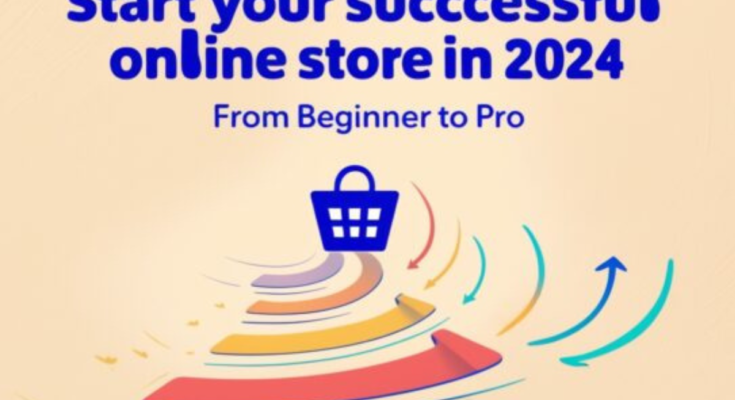Hello, Beautiful People! We’re glad you have arrived! Are you planning to launch an online store but need help getting it off the ground?
Well, you have come to the right place to get the information you need! These days, e-commerce is literally on the boom, and therefore, you can start your online business with minimal effort. You may want some additional cash, or you may want to do it full-time; in either case, opening up an online shop in 2024 will open many doors for you.
The right tools and strategies and a bit of elbow grease will enable almost everyone, from rookies to seasoned business personnel, to operate a money-making virtual shop.
Ready? Let’s go!
Table of Contents
Choose Your Niche: The Foundation of Success

The primary and most fundamental step in establishing a web marketing business that generates revenue is deciding on a suitable affiliation in a market.
A niche is a term that categorizes the type of products one sells, the customers that one sells to, and the marketing activities that it undertakes. There are instances where it is advisable to choose a niche that you love or know something about, as this makes the process more fun and increases the chances of success.
A Guide to Choosing a Suitable Niche
- Explore your passions: What do you enjoy doing? It could be sports, clothing, gadgets, or even interior design; whatever it is, ensuring it is a niche you want will help keep your enthusiasm in check.
- Evaluate existing preferences: Popularity indicators may include Google effects, availability on social networks, or positioning in Amazon’s best sellers.
- Determine your market: Who is your target market? Knowing what consumers want is essential for choosing appropriate solutions.
Niche Examples
- Eco-friendly and sustainable goods
- Health and fitness products
- Dog and cat Items
- Organization and Interior
- Electronics and their parts
Select the Right E-Commerce Platform
The final step is choosing the most appropriate online store builder after identifying your target market. Numerous e-commerce software solutions are available that allow even a complete novice to embark on the journey without any advanced IT skills. Here are some notable examples.
Best E-commerce Platforms In 2024
- Shopify is arguably the most user-friendly and self-explanatory platform. It provides all the tools required to set up and manage an online store, making it the most suitable for beginners. The platform has a variety of themes, applications, and payment methods.
- WooCommerce: for people who are used to the word press already, this is an application free of charge that a person can use to transform their word press into an online store. It enables different modifications of their default design, but it will take a little bit more technical know-how compared to Shopify.
- BigCommerce: BigCommerce is the best choice for any eCommerce platform owing to its ability to support and service thousands of users. This makes it suitable for anyone hoping to evolve their business into a multinational or large corporation. It also comes with advanced features such as built-in SEO tools and other marketing means.
- Wix eCommerce: This is ideal for novices wanting a straightforward drag-and-drop interface since templates can be altered, and basic e-commerce is introduced as a capability.
Details to Weigh Out When Determining a Platform
- User friendliness: If you are starting, you should look for a platform that requires minimum effort to set up and manage.
- Design limitations: Although some of the platforms may allow you to change the style and effects of your content more yourself.
- Growth Potential: The platform you choose should be capable of adapting as your business expands.
- Commerce Cost: Analyze different pricing strategies used, including the cost of transactions and monthly maintenance fees.
- As long as one has the appropriate software or tools to work with, establishing an online shop will be no challenge. This means there will be other core businesses while sustaining or recreating the shop.
Source Products: Where to Find What to Sell
Having set up your store, the next task is to make proper decisions on the kind of products to sell. The time is now ripe to either manufacture or purchase from suppliers or even go for a dropshipping model.
Product Sourcing Options
Create your products: If you are a creator or a designer, selling handmade products you make yourself would be one of the best options. This approach helps in managing quality and brand entirely.
Purchase wholesale: It is a strategy that involves buying goods, especially from producers or other distributors, in bulk to be sold at retail for a higher price. For instance, companies such as Alibaba or SaleHoo offer transformed opportunities for access to different suppliers across the globe.
Dropshipping: The best thing about dropshipping is the lack of storage space required to keep any products. What you do is post any products on your website whose owner is not you, and when a customer pays for the product, it is directly shipped from the owner’s warehouse to the customer’s address, thanks to third-party logistics. Dropshipping is easy even for the greenhorn’s thanks to programs such as Oberlo – which is particularly for Shopify and AliExpress.
Tips for Choosing the Right Product
- Research market: See the analysis of which products are selling more in trends on websites like amazon.com, etsy.com, and ebay.com. Also see posts of current selling items around the social media platforms.
- Expecting and delivery times: whether you are manufacturing your products or sourcing them from suppliers, you should ensure that there are quality control levels and speed of delivery of the products.
- Request for product samples: If you are dealing with a manufacturer or a dropshipping supplier, ask for samples of the products for quality assessment purposes.
- It is very important in gaining your customer’s confidence and providing a good buying experience with the right products and suppliers.
Design Your Store: Branding and User Experience

The fact remains that, in most cases, you only have one chance to make a first impression. Your online storefront also has those same capabilities. Therefore, the architectural design of your store should express the concept of your brand and ensure proper and pleasant shopping for all its visitors.
Some of the Steps Required to Design a Good Looking Store
Select a template: Most e-commerce solutions come with ready-made templates that you can customize to suit your business. Look for a neat, easy-to-use interface that is appropriate for your market.
Create a store: Implementing a cohesive brand strategy that includes a logo, a main color, and even a typeface promotes trust and familiarity. Logo makers can be found on websites like Canva, or a professional designer can be quickly acquired from Fiverr.
Mobile optimization: A few decades ago, this was unimaginable; today, a great percentage of online shoppers do so with phones. Therefore, ensure your store is accessible through portable gadgets, and that use is smooth regardless of the gadget being used.
Work on captivating product pages: Include nice looking product photography, expansive product descriptions as well as product reviews that can post their products encouraging customers to use them. It should be straightforward for the consumers to access the product they wish to buy and make the necessary payments.
Market Your Store: Drive Traffic and Boost Sales
You have identified your niche, established your website, and procured your inventory. One crucial step now concerns one of the most important aspects of web management—driving the audience to the site and converting them into purchasers.
Without appropriate traffic, the store is bound to incur losses, hence the need for deliberate marketing even at the accumulation of the stock.
- Social Media Marketing: Social media channels such as Instagram, Facebook, and Pinterest, among others, are the best ways of advertising products. People should be attracted to the store using appealing pictures and interesting information with informative text.
- Email Marketing: It would be great to create a list of interested parties and inform them of any company updates, such as products and offers. Some major services, like Mailchimp and Klaviyo, allow the easy creation and automation of such campaigns.
- Paid Advertising: To promote your products to a wider crowd, you can explore options such as Google Ads or Facebook Ads. Focus on certain groups of people to place your items in front of those who are most likely to be interested in them.
- Influencer Marketing: Find those with a large following and whose interests relate to the products you are marketing and get them to assist you in selling your products. Their followers will see your products and hopefully make a purchase, as well as see them promoted directly.
Scale Your Business: From Beginner to Pro
After you set up your shop and start making some reasonable sales figures, it’s time to consider scaling up. Expanding your e-commerce business doesn’t come just like that, but with the right techniques, small stores can be developed into big money-making ventures.
Strategies for Taking Your Online Store to the Next Level
Automate where possible: Focus on productivity using resources that can help in automating activities such as emails, social media advertisement, inventory management, etc., so as to concentrate on growing the business.
Add new products: After the existing products start doing well in the market, innovative companies look at the adjacent possibilities and increase revenues from other relevant products.
Encourage referrals: Provide good service to your customers and introduce referral links or good onboarding experiences for first-time users.
Adjust pricing: Consistently monitor the site’s activity and performance metrics and make changes to aspects like product content, images, calls to action, and other elements to enhance conversion rates.
Conclusion
In 2024, launching an e-commerce business is more convenient and possible than ever due to the numerous tools and tactics accessible, even to a novice. If you read this step-by-step guide, we will guide your e-commerce business from scratch to skyrocket in a very short time.
Regardless if you are looking for an easier job or you want to earn a wage and even a decent salary from running an online retail business, it is worth the trouble as the opportunities are there. Therefore, identify the market you want to operate in, create the site and brand, and begin fast-tracking your business towards an advancement in the e-commerce world!
What will be your first product, and how shall you make the store more engaging than all the other existing stores?
FAQ
- Do you require substantial funds to open an online store?
Actually, starting an online store poses little financial risk. Most services have cheap subscriptions, and one can also begin with dropshipping or printing on demand so that there are no stocks held at all.
- How much time is needed to create an online store?
Creating an online store will take a couple of hours or even a couple of days, based on how well you know the platform and how ready you are with the products and the branding.
- Which items should be offered in the online store?
Sell products that you are passionate about and ones that can be sold in the market. Follow the trend and think of things like green products, homemade products, or even selling e-books.
- What are some of the methods used to get customers to my online store?
There are different ways to get traffic. The most common include social media marketing, search engine optimization (SEO), email marketing, and pay-per-click ads. The catch here is discipline!
- Is it possible to operate an online store without quitting your job?
Of course! Many business owners open e-commerce stores while working full-time. With good time management skills, it is possible to do both.




